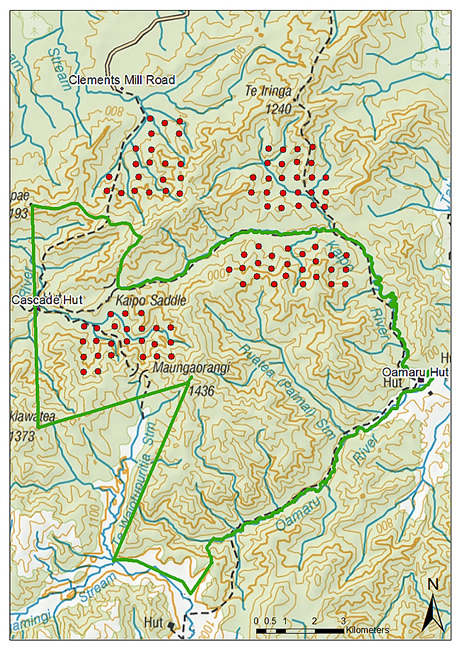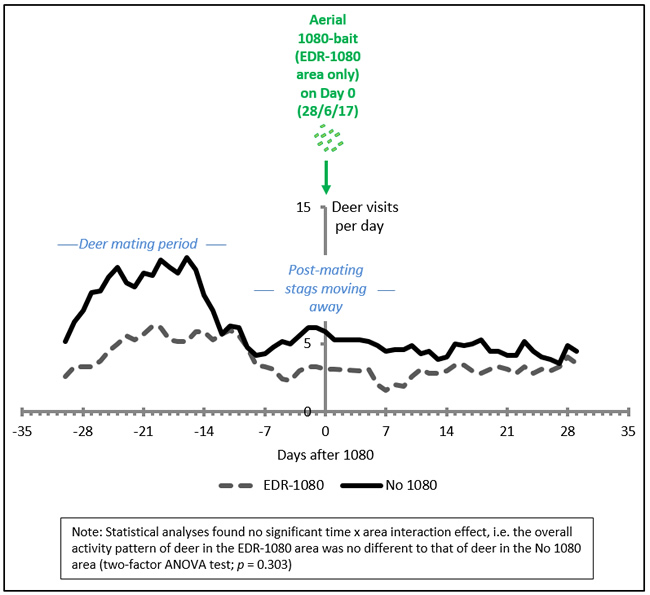Monitoring a sika deer population with trail cameras to assess survival following 1080 baiting
During aerial 1080-baiting operations against possums wild deer are also often poisoned. In areas where wild deer are valued by hunters and landowners, a deer repellent can be added to the bait to reduce this by-kill. Epro deer repellent (EDR) has been used for this purpose for more than a decade, and studies have demonstrated greatly reduced incidental by-kill of red deer and fallow deer when EDR is added to 1080 baits. However, the effectiveness of EDR in reducing the by-kill of sika deer has not been assessed.
A recent 1080 possum control operation over 10 000 ha in the Paemahi area of the Kaimanawa Forest Park gave Grant Morriss and Graham Nugent an opportunity to measure whether aerial baiting using EDR-coated 1080 bait has a significant impact on sika deer populations. Grant and Graham established two grids of trail cameras, each covering 600 ha, and compared the number of deer photographed a month before the 1080 operation (June 2017) with that a month later (July) (Figure 1). The team estimated the sika population in the Paemahi area to be 15–20 deer per square kilometre.

Two other trail camera grids were established in a nearby unbaited area of similar habitat and the sika deer populations there were similarly monitored to determine any natural changes in their sighting rate. Interestingly, rather than the usual method of deploying chewcards or traps to assess possum numbers, this approach provided an opportunity for the team to test the utility of trail cameras for monitoring changes in the activity and number of the target species (possums), and any behavioural interactions between deer and possums.
Grant and Graham examined over 10 000 images produced by the trail cameras, of which approximately 7000 were of sika deer. Numbers of photographs of sika were high throughout June (Figure 2), peaking at averages of five visits a day in the area where ‘EDR-1080’ bait was due to be dropped at the end of that month, and 10 visits a day in the ‘no-1080’ area. For both areas, deer sighting rates naturally declined by approximately 40% towards the end of June, due primarily to sika stags moving out of the area after mating (confirmed by video analysis). Importantly, there was no discernible change in sika deer sighting rates in either the poisoned or non-poisoned areas after the poison drop: deer sighting rates remained fairly constant for the next 4 weeks (Figure 2), regardless of area.

The picture was very different for possums (Table). The total number of visits to camera sites by possums over 30 days before and after the poison drop revealed a reduction in the number of possums following baiting from an average of three sightings per day pre-drop to zero post-drop. While not corroborated by one of the more usual means of monitoring possum numbers, the trail cameras suggested a near 100% kill of possums.
Table: Changes in the number of sika deer and possum visits recorded at 81 camera sites in the Paemahi area, operating for 33 days before and after 1080 baiting in June 2017.
| Total no. of deer photographed | Total no. of possums photographed | ||||||
|---|---|---|---|---|---|---|---|
| Pre-1080 | Post-1080 | % reduction | Pre-1080 | Post-1080 | % reduction | ||
| EDR-1080 areas | 173 | 107 | 38.1 | 191 | 0 | 100.0 | |
| Cascade | 102 | 51 | 50.0 | 99 | 0 | 100.0 | |
| Kaipō | 71 | 56 | 21.1 | 102 | 0 | 100.0 | |
| No-1080 areas | 294 | 164 | 44.2 | 13 | 13 | 0.0 | |
| Clements Mill | 108 | 45 | 58.3 | 3 | 9 | –200.0 | |
| Tiki tiki | 186 | 119 | 36.0 | 10 | 4 | 60.0 | |
However, the team wanted to look further into the issue of possible 1080 effects on the sika deer population in the Paemahi area. Based on camera sightings they estimated deer density across the region using three different extrapolation methods. Next, they conducted systematic ground searches over the baited area and counted and collected tissue for poison residue analysis from any deer carcasses they found. This provided a more detailed picture: 11 dead sika deer were found after the 1080 bait drop and all had 1080 residues. Averaged for the area as a whole, this equated to 1.6 carcasses per square kilometre, and accordingly the team estimated that approximately 10% of the sika population would have succumbed to 1080 poisoning. While this figure is at the upper end of the expected mortality if EDR is effective, the result did serve to illustrate an important point: for a high-density population such as that in the Paemahi area, 10% incidental deaths from a 1080 bait operation is likely to be negligible for the population of deer, with sika numbers likely to recover rapidly through increased reproduction and fawn survival as the result of more available food.

Daytime photo depicting a sika deer hind.

Night-time photos depict a possum (arrowed) approaching a sika deer.

Night-time photos depict a possum (arrowed) passing close to a sika deer.
So the project was a success in apparently killing 100% of the targeted possum population while sparing 90% of the valued sika deer. However, the original aim of the control operation was to reduce the level of bovine tuberculous (TB) in local wildlife, so what did these results tell the team about TB? First, TB had not been recorded in the area since the 1990s, and since the detailed necropsy of 32 wild animals found after the 1080 operation (20 possums and 12 deer) found no TB lesions, we calculated a 30–78% probability that the disease had already been eliminated (using the Proof-of-Freedom modelling framework (Anderson et al. 2013). This was not enough to declare freedom from TB, but enough to predict that a similarly effective repeat 1080 operation in the same area in 3 years’ time would be likely to achieve the sought-after 95% probability of localised TB eradication.
Secondly, analysis of the trail camera data allowed the team to observe interactions between wildlife species. In one sequence a possum was seen to pass close to a sika deer, and some mutual interest was exhibited between the two species (although no direct contact took place). This is just one isolated occurrence, but it supports the long-held belief that deer acquire TB from infected possums by their inquisitive investigation of the latter (e.g. nuzzling, sniffing objects of interest on the forest floor), and such behaviour is the major route of TB transmission between the two species.
It would appear that EDR can be relied on to limit incidental by-kill of sika deer in poison control operations, in addition to its already-known bait-aversion effects on red and fallow deer. Grant, Graham and other TB researchers now have a starting-point from which they can estimate the likelihood of TB persistence in the Paemahi area, which will help the next steps for full TB eradication there. The use of trial cameras has been highlighted as a promising new means of monitoring changes in pest populations following poison baiting, representing a longer-term ‘set-and-forget’ approach to pest monitoring than the more labour-intensive current means of setting, collecting and analysing chew cards, or setting, checking and recovering animals from leg-hold traps.
This work was funded by OSPRI through the TBfree programme.
Grant Morriss
Morrissg@landcareresearch.co.nz
Graham Nugent
D P Anderson et al. 2013. A novel approach to assess the probability of disease eradication from a wild-animal reservoir host. Epidemiology and Infection 141(7): 1509–1521. doi: 10.1017/S095026881200310X
